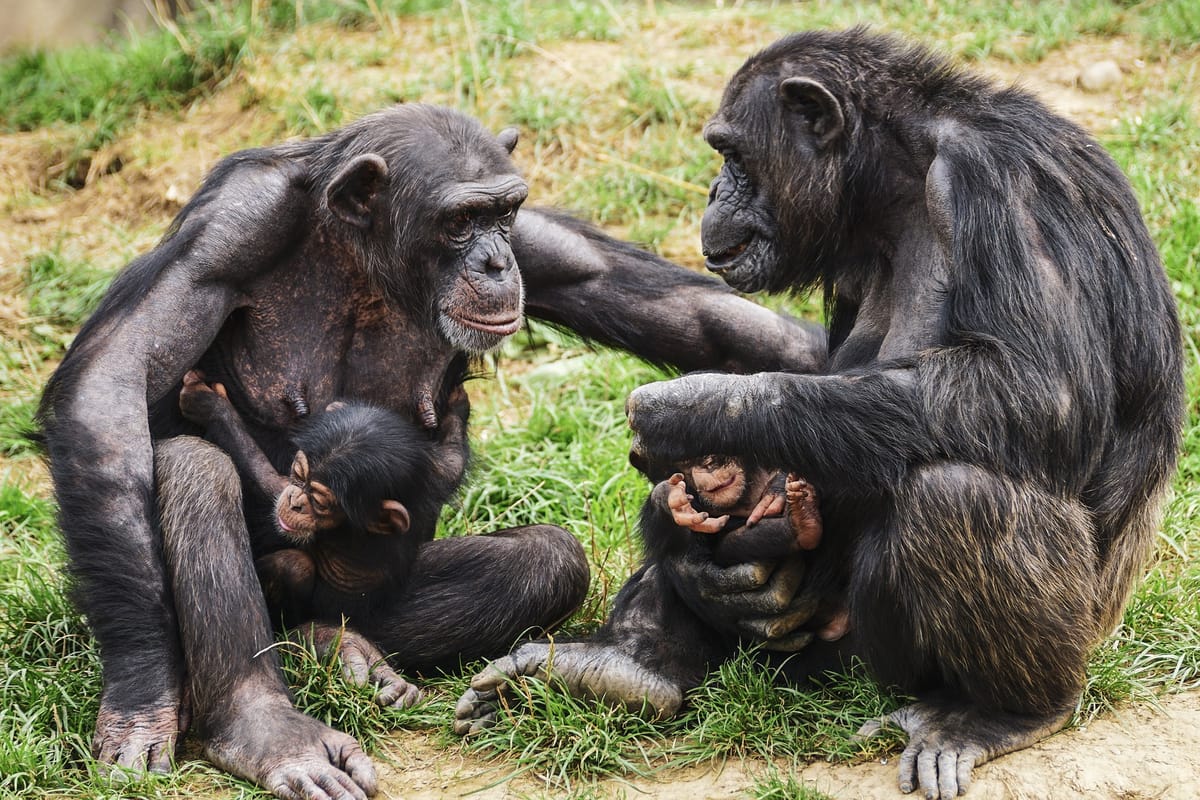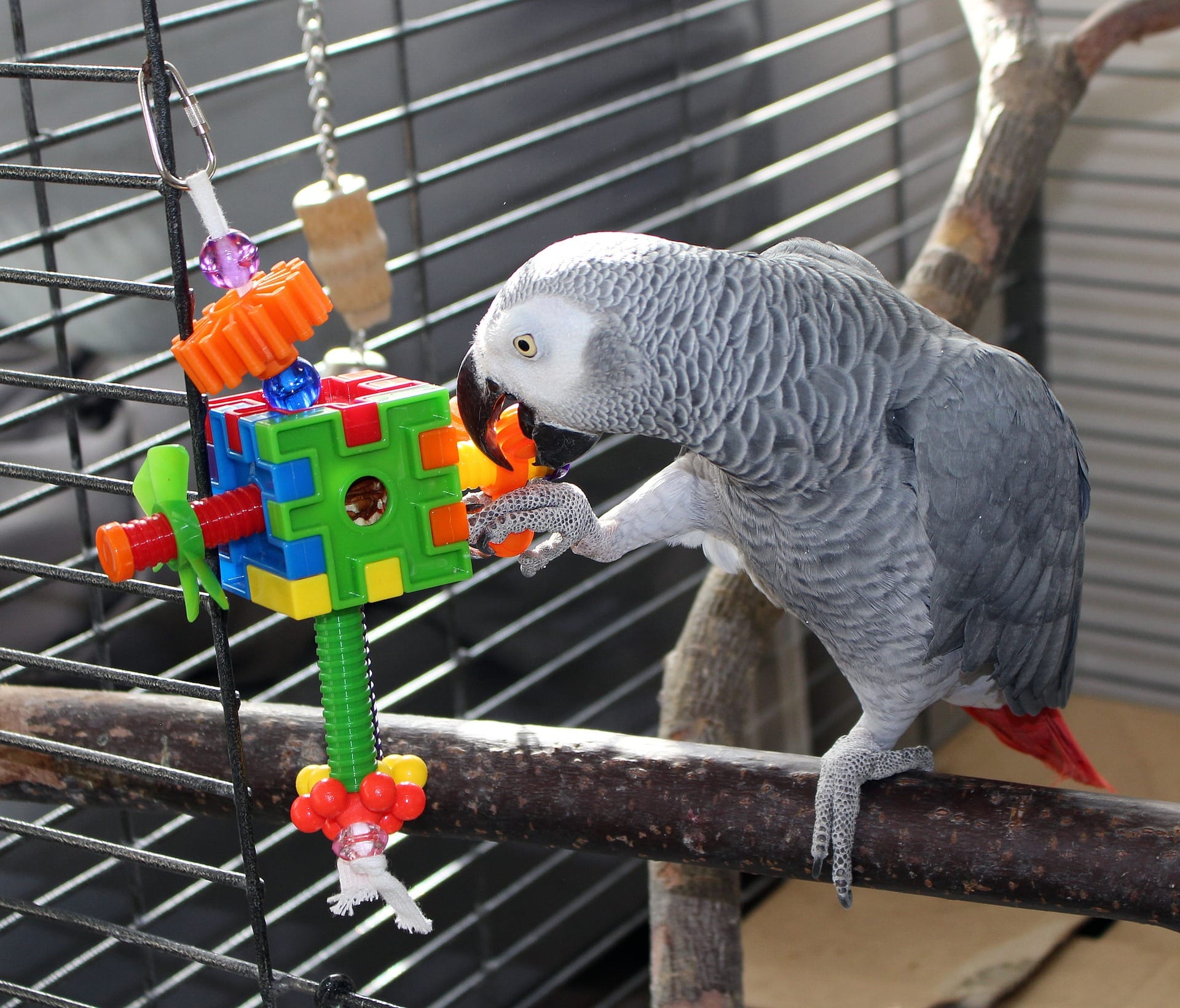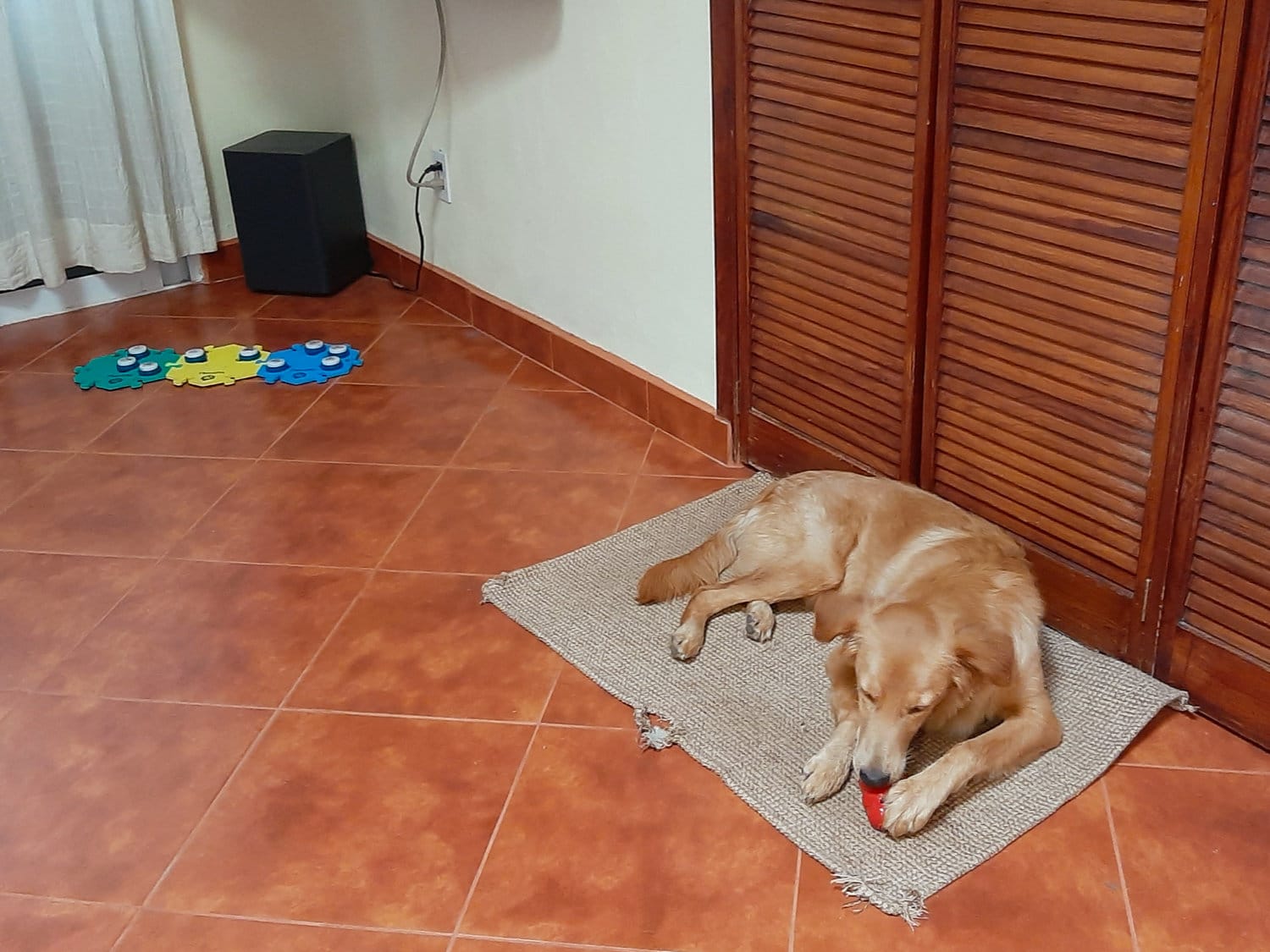If We Could Talk to the Animals
“Can we keep him?” “No.” “But it’s a TALKING DOG!”

CW: brief description of animal abuse
The Doctor Dolittle Dream
If I could walk with the animals
Talk with the animals
Grunt and squeak and squawk with the animals
And they could talk to me
The idea of animal language — among themselves, and between animals and humans — has fascinated me for almost my entire life. In my short story that speculated about crow language, I sprinkled references to the Talking Animals of Narnia, to Watership Down, and to Mrs. Frisby and the Rats of NIMH, three of the stories that prominently fed that fascination when I was in elementary school. My parents had a subscription to National Geographic, and the cover story about Koko the signing gorilla made a lasting impression on me, even as an eight-year-old. But it was in college that I really dived into the subject, devouring every book and article I could find in the university and public libraries on animal intelligence and animal-human communication — dolphins, gorillas, chimpanzees, parrots.
That would have been around 1990, but already most of the work was least a decade old. That’s because the entire field of research into animal language self-imploded while I was still a little kid. In 1979, chimpanzee researcher Herbert Terrace published a paper which not only announced that his own animal Nim had failed to demonstrate any real linguistic abilities, but asserted that all of the other projects teaching language to nonhuman primates had similarly failed.
The other major researchers working on animal language responded by defending their results, pointing out exceptions and flaws in Terrace’s logic. Terrace responded by pushing his points even farther. The argument, carried out largely via letters in scientific journals, was heated and personal. Scientists from related fields entered the debate, either attacking Terrace’s conclusions or lining up behind him. (Notable among the latter was linguist Thomas Sebeok, who said, “the alleged language experiments with apes divide into three groups: one, outright fraud; two, self-deception; three, those conducted by Terrace.”)
Eventually, this internal kerfuffle attracted the attention of broader media — one reporter called it “a series of mutual criticisms among ape language researchers which have made the War of the Roses look like a teddy-bears’ picnic by comparison.” As a result of the controversy, governmental sources of research funding for animal language studies shriveled up and vanished.
Within a few short years, Terrace’s assertion — that all the salient features of language were unique to humans — had become the mainstream line. As far as academia was concerned, the Dr. Dolittle dream was dead in the water.
The Three Main Pitfalls of Animal Cognition and Communication Science
Some healthy skepticism about “talking animals” is certainly warranted, especially since some of the past claims look pretty sketchy when you look beyond popular media and into the details.
Overinterpretation
At the top of that ‘sketchy’ list would be Penny Patterson, the primary researcher working with Koko the gorilla. Patterson constantly “interpreted” Koko’s signs and behaviors for her audiences, reading in meanings that impressed other humans, but were very unlikely to be accurate to Koko’s intentions.
Here’s just one example of many: to outside observers, Patterson would frequently translate Koko’s signing of ‘nipple’ by saying, “‘Nipple’ sounds like ‘people’; she actually means ‘people’.” Yet under other circumstances, Koko appeared to be intensely fascinated with actual nipples — a fact Patterson obviously knew very well, given that two former female employees eventually filed a sexual harassment suit against Patterson for pressuring them to disrobe and show Koko their nipples.
At the time of Terrace’s challenge, Patterson had published no data or scientific analysis, and although about a decade later she and a co-author did publish an overview of Koko’s “language acquisition” which contained some data, it was hardly enough to justify her history of claims for the gorilla. Meanwhile, Patterson’s continued tendency to overinterpret Koko’s communication is pretty obvious in any number of recorded interactions. I honestly cannot determine whether Patterson was wildly self-delusional about Koko’s abilities, or cannily playing on public sentiment in order to raise funds to support herself and the gorilla (whom she had winkled away from the San Francisco Zoo) — but either way, the kind of overinterpretation (and possibly, deliberate deception) that she regularly indulged in undermined any legitimate language features that Koko might have demonstrated.
Confirmation bias
Another pitfall is the way that the often-ambiguous input from animals lends itself to confirmation bias: given multiple possible interpretations, people will tend to choose the one that matches their preexisting beliefs or their desired outcomes.
For example, in the early 1970s, a scientist working with Washoe the chimpanzee signed “what that?”, indicating a swan swimming on a lake. Washoe — whose sign vocabulary did not include ‘swan’ — answered “water bird”. The scientist involved in that conversation considered this an instance of novel word creation, an indication that Washoe conceptualized that this specific bird inhabited the water and was distinct from other birds who did not inhabit water, and coined a new compound word to describe it. Terrace and some other scientists argued that she was simply narrating two separate things that she saw: water, and a bird.

Which is correct? The answer you pick might depend upon how badly you want to believe that chimps are capable of language creativity … or how invested you are in the idea that only humans can combine known vocabulary words to create novel ones. This is one place where I agree with Terrace: the truth “cannot be decided on the basis of a single anecdote,” or even two or three anecdotes, which is why science does best with large sample sizes and statistical analysis. But Terrace never seems to recognize the ways in which confirmation bias applies to his own arguments against animals’ language abilities.
Accidental human cueing
The third significant problem in animal-human communication is one of unintentional human cueing, often called the ‘Clever Hans effect’, after the famous German horse who seemed to demonstrate the ability to do basic arithmetic. Given an addition or multiplication problem, Hans would tap out the correct answer with a hoof. Several people tried to prove that Hans’ abilities were part of a scam by his owner — and failed.
Eventually, though, the psychologist Oskar Pfungst was able to show that Hans was simply picking up on subtle and unconscious body language from his owner and/or other humans who knew the correct answer to the question; it was that incredibly subtle body language that determined when Hans stopped tapping, no mathematics required.
Terrace attributed most of the apparent successes in non-human language-learning to the Clever Hans effect. Unfortunately, eliminating the possibility of human cueing is more complicated than simply isolating the animal subject from human input. The motivation to communicate is intrinsically social; this is no less true in animal-to-human communication than with human-to-human communication. (So-called ‘feral children’, raised in social isolation, do not spontaneously learn to speak.) Remove humans, and you also remove any reason for the animal to either learn or demonstrate the types of linguistic behaviors that a human might recognize.[1] And an animal that is kept too isolated — from humans and/or from their own species — suffers mental health problems that further confound their abilities.
Terrace’s Nim wasn’t just isolated from other chimps, he was separated from the surrogate human family that he’d bonded to, and subjected to conditions in the lab that were nothing short of abusive. For example, Terrace chose to train the ten-month-old Nim in a barren “classroom”, where any behavior other than sitting at his little desk paying attention was punished by stuffing the chimp into a four-foot-square plywood box that sat in the corner of the room and leaving him there alone, in the dark, while he cried and banged to get out.
By the time Nim was three years old he was on his third surrogate human mother-figure and intensely traumatized. Though still a decade away from full adulthood, he was already too strong to physically control, and he frequently bit his teachers and handlers, causing serious injury. Before the chimp’s fourth birthday, Terrace had canceled the project and returned Nim to the breeder.
Only after the unruly chimp was gone, and there was no further data to be gotten, did Terrace analyze the videos from the preceding three years and conclude that Nim had failed to exhibit anything other than cued signs and imitation. From reading his own words as well as memories of him by other people, I am left with the impression of a man whose outsized ego could not bear the idea that his own choices might have caused the failure of his project, or that anyone else might have succeeded where he had failed.
In addition to having put his research subject through repeated abandonment and trauma, Terrace also deeply mismanaged the language-teaching aspect of the study. First, Nim’s original surrogate family could not sign and only spoke English amongst themselves, which made as much sense, a later ASL teacher noted, as “putting a child in an Italian family to learn German.” Second, none of his many teachers during the first three years included native or fluent ASL signers, only people who were learning individual signs on the fly, just barely staying ahead of the chimp. This meant not only that the teachers’ signs themselves were inconsistent, but also that for the first three years of his life Nim was only exposed to a kind of pidgin sign, with none of the syntax and grammar of true ASL. Even in the final few months of the study, almost all of the people he interacted with were novice signers themselves; he had less than a year of any interaction with a fluent signer.
Yet Terrace considered Nim’s failure to spontaneously produce complex signed sentences to be conclusive evidence that primates inherently lack the ability to use language.
We’ve Been Here Before
“Learned journals of past decades,” wrote linguist William Stokoe in 1979,
… are filled with studies proving that sign language is less than language in grammar, syntax, accidence, and semantics, or the power to render ideas precisely. Psychologists carried out elaborate research programs proving that deaf persons lack the power of abstract thinking. Even a linguist as distinguished as [Leonard] Bloomfield accepted without question that kind of “research” and supposed that nothing in deaf people’s signing is other than derived from, or representative of, some part of spoken language.
For well over a century, the signs employed by Deaf people in America were simply considered poor replacements for comparable English words. It was Stokoe himself who changed that, when in 1960 he published the first detailed linguistic analysis of what he dubbed American Sign Language, arguing that it did in fact possess grammar, syntax, and other features of a full and complete language. For this claim he was “vehemently attacked” from all sides, even by his faculty colleagues at Gallaudet College for the Deaf.
Yet Stokoe persisted in his studies, published many more papers, engaged other linguists … and within two decades, the research and analysis he spearheaded had turned the tide, as ASL (and other signed languages) began to be broadly accepted as true language. This had a revolutionary effect upon the lives of Deaf people, in America and worldwide.
Reading this 1979 account, I was particularly struck by the line, “Psychologists carried out elaborate research programs proving that deaf persons lack the power of abstract thinking,” because it so closely mirrors the attitude of many behaviorists toward animals: that because (in their view) animals do not have language, they cannot have thought or any kind of inner life, and are therefore essentially machines reacting to external stimuli.
Fortunately, Not (Quite) All Scientists
Though after 1980 there was no funding to be had for beginning language projects with new animals, a few researchers managed to continue working with existing language-trained animals, in part by moving to private institutions and fundraising directly from the public. Most notably, these included Sue Savage-Rumbaugh, who worked with bonobos Kanzi and Panbanisha until the latter’s death in 2012, and Irene Pepperberg, who worked with African Grey parrot Alex for thirty years until his death in 2007, and continues to this day with Grey parrots Griffin and Athena. Unlike Terrace, who rarely interacted with Nim himself, Savage-Rumbaugh and Pepperberg formed close social bonds with their research animals. Unlike Patterson, they and their teams conducted rigorous scientific studies and published multiple careful, peer-reviewed papers.
Work by Savage-Rumbaugh’s team included:
- a 660-question test of syntactic comprehension of spoken English in which Kanzi, then aged eight, outperformed a two-and-a-half year old child, and
- the groundbreaking proof that nonhumans could and did not only use words to communicate imperatively (to request or demand) but also declaratively (to inform or relate) … even if they did the latter less often than human children.

But it’s Irene Pepperberg’s work that I think is the most important. With her first parrot, Alex, Pepperberg adopted a highly social style of teaching called the Rival/Model technique. Instead of the two-way, one trainer to one subject approach used by other animal language researchers, Pepperberg used a three-way process, with two humans and the parrot. Pepperberg and a research assistant would take turns playing out the scenarios that they wanted Alex to learn, showing examples of both word use and results. The research assistant thus became both a model for Alex’s learning and a rival for Pepperberg’s attention.
The interest, flexibility, and creativity made possible by this approach outstripped even the most optimistic expectation. When Pepperberg began her parrot studies, the prevailing theory of animal intelligence held that cognition was a function of brain size. Birds, with brains the size of a walnut, were considered to be … well, ‘bird-brained’.
But under Pepperberg’s tutelage, her first pupil Alex learned:
- to name over 100 different objects (e.g., key, spool)
- to identify seven different colors and five shapes
- to identify types of materials (e.g., wood, wool, paper)
- relative concepts (e.g., same/different, bigger/smaller)
- numbers up to eight (including both visual and auditory counting)
- the relationship of abstract numerical symbols to quantity
- to add two or three numbers or sets of items
Alex also coined one portmanteau: after his introduction to an apple, he called it a ‘banerry’, combining the known fruit names ‘banana’ and ‘cherry’. He had learned to answer questions about comparing two objects such as “what’s different?”, where the correct answer might be “shape” or “color” or, if the two items were identical, “none.” He then, without any additional training, transferred the use of “none” from ‘same/different’ questions to ‘bigger/smaller’ questions, and eventually offered up the word “none” to mean ‘zero’, a concept that he had never been taught.
“[Alex’s] use of ‘none’ in a zero-like manner was noteworthy,” wrote Pepperberg, “in that it arose spontaneously and showed he understands that none represents absence of objects as well as information.” It is especially impressive and fascinating given that ‘zero’ is a concept many human cultures have never possessed — the Roman numeral system, for one example, does not include zero.
Just Fucking Stop Already
I wasn’t initially intending to relegislate a decades-old scientific controversy in this essay, but while researching I found out that Herbert Terrace is still at it, and I got mad. With the 2019 publication of the awkwardly titled book Why Chimpanzees Can’t Learn Language and Only Humans Can, Terrace doubles down on the claims that made him famous forty years earlier, this time for a non-scientist audience. (Although he often writes specifically of chimpanzees or apes, Terrace explicitly states that his “conclusions apply to all claims that animals can learn language”, including dolphins, parrots, etc. I’m sure it’s a coincidence that this focus allows him to completely ignore Pepperberg’s entire body of work, which happens to clearly disprove several of his assertions.)
There are few things in this world that make me more furious than a highly credentialed scientist blatantly lying to an uninformed public.
“Animals lack not only grammar but also words,” Terrace boldly claims, and then — to my mind, somewhat bizarrely — defines ‘using words’ as “a conversation between a speaker and a listener who take turns sharing information”.
First, I’m sure every college professor who’s ever given a lecture would be interested to learn that they weren’t “using words” at the time. Frankly, I see no reason why symbolic information-sharing must be immediately bidirectional in order to qualify as ‘word usage’ … except that unidirectional symbolic information-sharing is so thoroughly documented among animals that Terrace’s claim — that only humans can use words — would otherwise instantly and spectacularly collapse.
But second, I would submit that — because the act of asking a question is itself communicating information (of what specific knowledge the questioner wants to receive) — any successful question-and-answer exchange is an example of information-sharing in turns, so long as 1) the question-and-answer pair is not learned by rote and 2) the answer is not produced by chance. Point one can be disproven by use of known words in entirely novel but contextually sensible combinations; point two can be disproven by statistically analyzing a large number of interactions and comparing it to the statistics of chance. Even though Terrace himself didn’t prove that with Nim, other researchers have, with animals of several different species.
I could spend tens of thousands of words picking apart the gaps in logic and internal contradictions in Terrace’s book — like the way that he suggests in one sentence that Kanzi didn’t understand the word ‘pour’, and then in the very next asserts that “from previous training, Kanzi knew that vacuums couldn’t be poured.” The whole book is rife with factual errors,[2] cherry-picking, confirmation bias, and other logical fallacies.
There are few things in this world that make me more furious than a highly credentialed scientist blatantly lying to an uninformed public.
Terrace did make me laugh out loud once — albeit in a bitter, ironic, you’ve-got-to-be-fucking-kidding-me kind of way — when he suggested that we all dismiss Kanzi’s besting of a human child on a test of syntactic comprehension because “similar performance was obtained with dogs, a species not known for its linguistic ability.”
He says this despite being completely familiar with the studies involving the border collie Chaser. After three years of daily training, Chaser was put through a series of four rigorously controlled tests, each explicitly designed to address assorted objections made by a few scientists to a prior study of the linguistic comprehension of another border collie, Rico. In a statement that I can only see as intentionally designed to mislead his readers, Terrace claims that “neither experiment claimed that border collies have any linguistic knowledge,” as though the scientists working with Rico and Chaser agreed with his own assertions that animals don’t understand words and cannot learn any features of language.
But that’s flatly false. The Chaser paper did not make any claims one way or the other about whether border collies have innate linguistic knowledge, but it did explicitly claim that this specific dog was able to learn and conclusively demonstrate several key features of language.

First, Chaser showed that she had learned and retained the proper nouns (in spoken English) for 1,022 different objects, proving that she had “the ability to discriminate many nouns phonetically, the ability to discriminate many objects visually, a sizable vocabulary, and a sufficient memory system.”
Second, the experimenters directly tested the idea that “animals cannot understand that things have names”:
Recall that in the Rico study (Kaminski et al., 2004), Bloom (2004) was not convinced that words for Rico conveyed reference — that labels actually referred to objects, independent from the meaning of an associated command. For example, when Rico was told to “fetch sock,” did Rico comprehend that the label “sock” referred to a specific object and separately comprehend that the word “fetch” meant that he should produce a specific behavior involving that specific object? If Rico actually treated the label “sock” as a command to “fetch sock” only, then it would not be evidence that he understood reference. That is, Rico may not have understood that the label “sock” referred to a specific object, independent of a behavior directed toward the sock. Thus, Bloom argued that Rico “might not understand reference at all and might be limited to associating the word spoken by the owner with a specific behavior” (p. 1604). If so, then Rico’s word learning may have little to do with language learning as exhibited by humans.
So Chaser was taught three different ways of interacting with objects — ‘take’ (in her mouth), ‘paw’, and ‘nose’, in addition to her thousand-plus nouns. For the trial, she was asked to perform a series of specific actions, such as “take ABC” or “paw lamb,” using verbs and nouns she’d never previously heard in combination. Her perfect execution “clearly support[s] the conclusion that Chaser understood reference — that the verbal noun of an object referred to a particular object with distinct physical features independent of actions directed toward that object.”
But wait, there’s more! The third experiment showed that Chaser could learn not only proper nouns (like the unique names of toys or people) but also common nouns (symbols that refer to categories of objects). After being taught the labels ‘frisbee’ and ‘ball’ using a subset of examples from her 1,022 named objects, she was able to correctly generalize the physical properties involved and select other ‘frisbee’ and ‘ball’ objects which were not used in training. Furthermore, she learned that all 1,022 objects that she worked and played with were called ‘toy’, and when asked to “fetch a toy” would only select one of those items, ignoring the many physically similar available items which she had not been allowed to play with, suggesting that she was capable of abstract generalization based on functionality.
Finally, the fourth experiment replicated, with additional controls, a test given to Rico. It showed that Chaser could also use exclusionary principles to respond to new, unknown words. For example, if she had never learned the word ‘noodle’ before, and was asked to “fetch noodle” from an environment where there was one toy she’d not seen before amongst many toys with known names, Chaser was able to reason that ‘noodle’ must refer to the new toy, and return with it. Afterward, if the ‘noodle’ was placed among both known and unknown objects, she would respond to “fetch noodle” by picking up the same toy, showing that she did continue to associate the name with the specific item.[3]
The experimenters conclude thus [emphasis mine]:
Together, our four experiments provide compelling evidence that Chaser understood that objects have names. She demonstrated sensitivity to our social cues that that enabled her to map words upon the referents. To our knowledge, Chaser learned more proper-noun names (1022) than any other dog, fulfilling our strict learning criteria and satisfying 1000’s of statistical tests. Chaser demonstrated the one-to-many name–object mappings required for common nouns to represent categories. Conversely, she also understood that an object may have more than one name, such as a unique proper-noun name as well as one or more common-noun names (“ball” and “toy”). By successfully responding to random combinations of names and commands, she demonstrated her understanding that names refer to objects, independent of the behaviors directed toward those objects. Thus, she understood the difference in meaning between names and commands and treated their combination the same way humans do. Combined, these experiments provide clear evidence that Chaser acquired referential understanding of nouns, an ability normally attributed to children.
Of course Terrace, in reviewing these studies, won’t admit any of this, because he’s already categorically stated both that “animals lack not only grammar but also words,” and that “only humans know that things have names.” So instead he’s got to obfuscate and say the dog “has the ability to differentiate the sound patterns of English words and to use them as discriminative stimuli to solve a problem.”
Yeah, that’s what we’re all doing, buddy. Even you.
Researching, composing, and sourcing informative essays like this one require many, many hours of unpaid work. If you appreciate it and can afford to, please help me continue writing with a paid subscription at the Member or True Fan levels. Or you can leave a one-time, pay-what-you-can tip. Thank you for your support!
Talking Dogs Captivate the Internet
In 2018, a speech-language pathologist named Christina Hunger got a new puppy, Stella. Noticing that Stella was displaying behaviors very similar to those exhibited by children just before they begin speaking, she decided to try using AAC (Augmentative and Alternative Communication) tools, originally meant for speech-impaired humans, with the puppy.
She chose large buttons that played back a recorded word when pressed, placed together on a floor ‘soundboard’ where Stella could activate them with her paws. In November 2019 — when 18-month-old Stella was up to 29 words and regularly combining three and four of them at a time — videos of Stella “talking” went viral online, ultimately attracting major attention from the news media.
After that, other people started setting up buttons for their dogs and recording the results.[4] The co-founder of CleverPet, a startup that originally had made game consoles for bored pets saw the Stella videos and promptly pivoted to making a button-based communication system designed specifically for pets instead of humans.
One of the alpha testers for that system (branded as ‘FluentPet’) was a sheepadoodle puppy named Bunny. Bunny was both adorable and a quick study on the buttons, and in less than a year, Bunny was a TikTok star with millions of followers and national media attention, sparking a whole new wave of button pets, some of whom achieved their own virality in turn. Meanwhile, FluentPet was producing buttons that were smaller and easier to press … and the first trickle of ‘talking cats’ began to appear.
Of course, the problem with videos shared on social media is that they are intrinsically cherry-picked — no one is showing off the pets that ignore the buttons completely, or take months and months to make progress. Even among the best users, often only the most interesting and impressive videos are shown, which means viewers lack context about what’s happening the other 99.9% of the time. If a pet is pressing one sensible combination of words for every hundred combinations of random gibberish, well, that’s a very different situation than the reverse ratio.
And even some of these cherry-picked videos are ambiguous, especially where abstract concepts are involved. Is a pet who presses a “love you” button actually experiencing an emotion that a human would recognize as ‘love’? Maybe she has simply noticed that after saying “love you”, she’s more likely to get whatever she asks for next. Or perhaps she is just pressing a button that she’s learned makes her person respond with affectionate words and tone. (But not, as many people assume, just random words in a sweet tone of voice! A recent study has shown that dogs can separately distinguish words and tone, and respond differently to neutral words and praise words given with identical intonation.)
Yet even among human beings, there is plenty of variation in what we think “love” means … and humans also sometimes say “I love you” as a ploy to get something we want (see especially: young children and horny men). So this ambiguity doesn’t really distinguish a dog or cat from your average human toddler with a similar vocabulary level.
To be clear, the idea with soundboards is not to train pets to push a button — or even a sequence of multiple buttons — on command for a food or praise reward. That’s just operant conditioning, and while it has its uses, it isn’t really communication, any more than a dog trained to bark at the “speak” cue is communicating.
Instead, the pets in question are using the buttons — sometimes a handful of words, sometimes well over a hundred — unprompted and on their own terms, when they have something they want to communicate. Not that pets are “speaking” grammatically correct English (or other language); even if that were within their capability, it would take far more than the 150 words that the current top learners have access to. Instead the buttons represent a kind of pidgin or simplified learner’s English, very much like a human toddler’s early language attempts.
Typically, button usage does start with requesting objects or actions the pet finds directly rewarding (like play, food, or going outside), and some animals never progress beyond those basics. But some pets have also used the buttons to:
- express emotions,
- tell their humans when they are sick or hurt,
- ask about absent friends and family,
- narrate something that is happening (including things the listening human doesn’t know about),
- complain about something they don’t like,
- request help on another pet’s behalf,
- speak to another pet in the absence of a human,
- ask a new person’s name,
- and even talk about the weather.
A few pets with extensive vocabularies (upwards of fifty words) have combined existing buttons to refer to new concepts, ones never modeled by a human — like ‘water bone’ or ‘cold thunder’[5] for an ice cube, or ‘squeaker car’ for an ambulance. Pets also use buttons that humans intend for one idea to mean something else — amusingly, one of the most common reports from owners of both cats and dogs is that buttons for ‘poop’, ‘potty’, or ‘litterbox’ get off-label use as something like insults or curses, words the pet will press when they are angry or displeased. And I’ve seen more than a few videos that show an extended back-and-forth conversation between pet and human.[6]
All of the above actions beyond the basic ‘press button to receive food’ are, according to a large and vocal contingent of scientists, things that Only Humans Can Do. Despite assorted evidence to the contrary, these people will insist that non-human animals “live only in the present” with no sense of time, that they don’t have the creativity to create new words, that they don’t possess the mental constancy necessary to conceptualize objects or beings not currently present, that their communication is always one-way and never a conversation.
Chasing Human Exceptionalism
A whole lot of humans seem to have an intense psychological need to believe that we as a species are special and unique, somehow categorically different from, and therefore better than, every other animal. In just my lifetime the supposed categorical difference has cycled through a long list of ideas — emotions, time sense, tool use, cognitive flexibility, transmission of culture, theory of mind — each eventually proven wrong and supplanted by the new “real reason” the human species is unique and special. And every time, a bunch of people get seriously pissed off and twist through all kinds of semantic contortions trying to argue why the proof doesn’t count.
It’s all anthropocentric bullshit. Often, the exact same behavior is labeled is ‘success’ when performed by a human child, and ‘failure’ when performed by an animal. Every time science shows an animal can do something that was previously assigned only to humans, humans redefine the thing to exclude whatever the animals are doing. The goalposts of ‘language’ have been moved so many times now that there is nothing even approaching a general consensus in the scientific community about exactly which set of qualities communication must possess to qualify for the ‘language’ label.
If we really allowed ourselves to contemplate that reality, the cognitive dissonance would shake our society to the core.
Based on the evidence to date, it is highly probable that at least some — and perhaps many or all — species of social animals have an intelligence and an inner experience similar to that of a human child of between two and five years old. If we admitted that — if we really allowed ourselves to contemplate that reality — the cognitive dissonance would shake our society to the core.
It would disrupt our whole food system, for starters, but it would also mean that many of us who genuinely love our pets would have to rethink the authoritarian way we treat them. It’s just so much easier to believe animals are both Other and Lesser, so we can choose how much empathy to show them; so much more convenient to assume that Humans Always Know Best, so we don’t have to allow non-humans any agency in their lives.
Just Add Pandemic
The only reason I said that child-equivalent cognition is “highly probable” rather than “certain” is because animal cognition studies have by necessity only worked with a few members of each species. Teaching an animal of another species to speak a new language, even a pidgin one, takes a lot of personnel and time and money, and — thanks to Terrace and his ilk — all three have long been in short supply.
Until now. By 2020 there were hundreds of households around the world, each doing something not so far removed from the ape language studies like Project Nim … except not with wild animals, but with dogs, who have been domesticated for tens of thousands of years and have already evolved specific traits for improving bidirectional communication with humans.
And then we got a global airborne pandemic. All those people home with their pets all day, scrolling social media for anything less terrifying than mass death. A lot of lonely people who didn’t have pets went out and got one: pandemic puppies were a whole thing. And on TikTok and Instagram and YouTube: hey look, it’s a talking dog!
This has a very good chance of being the animal cognition revolution I’ve been dreaming of for thirty-odd years.
While some people were baking sourdough bread, others were introducing their dogs (or cats or horses or ferrets or chickens) to word buttons. The hundreds of households became thousands.
Meanwhile, scientists had also been stuck at home, unable to proceed with any of their regular data collection. One such was Dr. Federico Rossano, director of the Comparative Cognition Lab at the University of California San Diego. With multiple advanced degrees in linguistics and psychology, his prior research had mostly focused on bonobos, orangutans, and preschool human children. But with his existing research subjects inaccessible due to lockdown, Rossano decided to take the opportunity offered by FluentPet: to marshal remote data from all those engaged owners and their button-pressing pets into a giant citizen-science project.
The resulting studies, with sample sizes ranging from many hundreds to several thousands at a time, are operating at a scale far beyond traditional laboratory-based animal communication science, which has typically had to make do with just one or two apes, dolphins, or parrots at a time.
What little data we’ve had over the decades points to significant variability from one animal to the next. For example, it’s now clear that Irene Pepperberg got remarkably lucky with her first parrot, Alex; despite highly similar training and environments, the other four parrots she’s worked with — while doing things that would have been astonishing before Alex — have yet to match all of his many accomplishments.
But when you have tens of thousands of different animals, not only do you have better odds of finding the remarkably competent outliers, you have enough information to begin to make generalizations at the species level. With always-on cameras and app-connected buttons, you could have an unimpeachable source of data that even the staunchest anthropocentrist will be forced to acknowledge.
In short, this has a very good chance of being the animal cognition revolution I’ve been dreaming of for thirty-odd years.
Rossano is of course highly aware of the decades-long stigma in academia against the idea of animal language, and the aforementioned pitfalls for animal cognition scientists. “We have a lot of sanity checks in place,” he says, “to make sure we’re not being fooled.” Their research is carefully designed to preclude the typical counterarguments and discrediting tactics — for example by using around-the-clock video recording, large-scale multifactor data analysis, and staged double-blind experiments. And yes, the staunch human exceptionalists are furious, and Rossano’s team is getting pushback. But they’re pressing on nevertheless.
The Rossano team published their first paper earlier this year; a second is already accepted, four are in the submission stage, and several more are in progress. More studies are starting up all the time, and anyone using buttons (FluentPet or any other brand) to communicate with a domestic animal can sign up to participate.
Joining the Button Brigade
That’s the scientific effect of this development, but for me there’s a personal one as well. Despite my continued belief in the possibility of better human-animal communication, I’ve never had a way to fully bridge the gap with the animals in my own life. By this point I know both cat and dog body languages just about as well as any human can, and I’ve inferred the meaning of some vocalizations from context. My prior and current pets (two dogs and seven cats) have demonstrably learned the meaning of certain spoken human words and phrases — for some animals I’m sure of only two or three, for others multiple dozens. But that only takes me so far. Most of my pets have clearly tried to say more to me than I was capable of comprehending.
This has never been more true than with the older of our two current cats. Gracie has the widest range of distinct vocalizations I’ve ever heard from a pet — probably fifty distinct types of meows and trills at a minimum — and over the eight years of her life I’ve figured out … maybe twelve of them. She has a specific tone that she uses to talk about a rainstorm, for example, although I still don’t know exactly what she’s saying about the rain. Is she just informing me that it’s happening? Is she complaining that it’s loud? (She doesn’t talk about quiet misty sprinkles, and I’ve figured out from other interactions that she has painfully sensitive hearing.) Or is it something else that I haven’t even thought of?
The other three-quarters of the time that Gracie is monologuing I haven’t got the vaguest idea what she’s on about.
But now, at least, I have a chance at finding out.
Inspired by an author acquaintance who was an early adopter of the cat-sized buttons and now literally has the most verbal cat in the world,[7] I’d been teetering on the verge of trying buttons for months. I kept weighing the considerable expense against the odds of Gracie’s complete indifference … and not quite committing to it, until the surprise addition of a puppy to the household (on average, dogs have a much higher uptake rate than cats) pushed me over the edge.
Well, the puppy picked up the concept in under twenty-four hours, and now it’s a whole thing. Teaching my pets Button Pidgin quickly became my newest Autistic fascination.[8] I’m going to resist the temptation to let Nine Lives become All Talking Pets All The Time, but I will post occasional updates about our progress on my website blog. (No videos so far, as I don’t yet have dedicated cameras for the soundboard area.) But the more I work on this, the more thoughts I have on the subject, so if you’d be interested in another Nine Lives on animal cognition and communication in the future, let me know in the comments!

And of course I’m offering my data to the UCSD lab, too … doing what I can to further the cause of science. After listening to a couple of long interviews with Dr. Rossano, I believe that he is fully open to the possibilities but also committed to the data — and I really do want to know what the science shows, even if the answers aren’t everything I might hope for.
But if I could have one wish, about all of this? It would be that Dr. Herbert S. Terrace lives long enough to have to eat metaphorical crow.
Further resources:
To read more about Project Nim, and the rest of Nim’s life after Terrace rejected him, see Elizabeth Hess’ extremely well-researched book Nim Chimpsky, the Chimp Who Would Be Human.
For a clear first-hand recounting of the scientific controversy sparked by Herbert Terrace, and the field’s subsequent implosion, see Irene Pepperberg’s article “Animal language studies: What happened?”
I also highly recommend Alex and Me, Irene Pepperberg’s memoir of her thirty years with Alex the African Grey parrot.
The book Chaser: Unlocking the Genius of the Dog Who Knows a Thousand Words, co-written by Chaser’s trainer and companion Dr. John Pilley, provides more stories of their life and work together, and Chaser’s progress in the aftermath of the groundbreaking paper.
Christina Hunger’s memoir How Stella Learned to Talk describes how her experience working with nonspeaking autistic children led to pioneering this new form of animal-human communication.
The Animal Cognition entry in the online Stanford Encyclopedia of Philosophy covers a lot of concepts mentioned above as well as related ideas and issues, in a well-organized overview.
(Updated August 2024) Tashi now has a comprehensive vocabulary of at least 150 English words, and his soundboard is up to 100 buttons. Occasionally I find the time to edit and post a video of Tashi on Instagram: talkingwithtashi.
Also, if you want to try FluentPet buttons with your animal friends, you can use my affiliate link and code TASHI for 12% off.
(Updated August 2024) Here are a few of my favorite currently-posting talking-button cat and dog accounts. (Instagram links below, although many are also on TikTok and/or YouTube under the same handles — just search.)
- bastianandbrews
- cachecowadventures
- curiositythegiant
- elsiewants
- flounder_meatloaf
- letsgoripley
- ohmymylo
- puppyparkerposey
- twiggyandhercatcatfriends
- whataboutbunny
And do not miss the cockatoo who converses with a tablet (and makes video calls!):
Researching, composing, and sourcing informative essays like this one require many, many hours of unpaid work. If you appreciate it and can afford to, please help me continue writing with a paid subscription at the Member or True Fan levels. Or you can leave a one-time, pay-what-you-can tip. Thank you for your support!
Note here that I am leaving open the possibility of interspecies linguistic behaviors which differ sufficiently from humans’ that we do not currently recognize them as such. ↩︎
As a hyperlexic autistic, I especially loved his blanket statement that “language development is retarded” in autistic children, who “rarely begin to produce words until they are two years old.” Tell me you know nothing about autism without telling me … ↩︎
Note that without repetition and reinforcement of the new name to make it salient — for example, a play session using the new ‘noodle’ — the memory of the name would fade over time. This was still better performance than the human beings conducting the experiments, who couldn’t come close to matching Chaser’s long-term memory of 1,022 different names; they had to write the assigned name on the surface of each toy. ↩︎
If I’d had a dog at the time, I would have done the same. But Tessa was years gone by then and the human AAC buttons were next to impossible for a small cat to operate. ↩︎
“Thunder” because of the rumbly sound the ice dispenser in the refrigerator makes! ↩︎
This list covers only the types of communication that I have been personally convinced that at least some dogs and cats have intentionally produced. These instances may be outliers due to either training or natural aptitude or both. There are some other possible types of pet communication about which I am currently either highly skeptical or reserving opinion. ↩︎
According to data collected by Rossano as of September 2023, Elsie is the most verbal cat enrolled in the CCL studies. If there’s another cat out there using more human words, the internet doesn’t know about it! ↩︎
For those of you not familiar with autism, one of the predominant traits is the tendency to hyperfocus on a particular topic or area of interest, in a way that is far more thorough and all-consuming than, say, a neurotypical person’s hobby. This can be a single subject throughout one’s entire life, or it can be a series of deep dives into different subjects. The older, observational psychological literature that views autism as a disorder calls these “repetitive and restricted interests”; more recently the phrase ‘special interest’ has been used, and also adopted by some Autistics. I’ve personally been unable to get comfortable with the connotations of ‘special interest’; ‘Autistic fascination’ feels more accurate and less loaded. ↩︎




